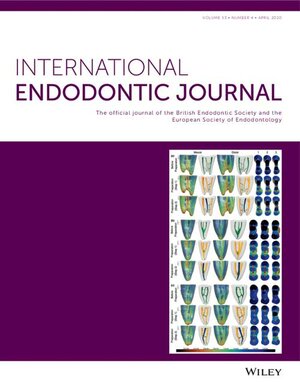MiR-143-5p regulates the proangiogenic potential of human dental pulp stem cells by targeting HIF-1α/RORA under hypoxia: A laboratory investigation in pulp regeneration
Abstract
Aim
Angiogenesis is a key event in the successful healing of pulp injuries, and hypoxia is the main stimulator of pulpal angiogenesis. In this study, we investigated the effect of hypoxia on the proangiogenic potential of human dental pulp stem cells (hDPSCs) and the role of miR-143-5p in the process.
Methodology
Human dental pulp stem cells were isolated, cultured and characterized in vitro. Cobalt chloride (CoCl2) was used to induce hypoxia in hDPSCs. CCK-8 and Transwell assays were used to determine the effect of hypoxia on hDPSCs proliferation and migration. Quantitative real-time polymerase chain reaction (qRT-PCR), Western blotting (WB) and ELISA were performed to assess the mRNA and protein levels of HIF-1α and angiogenic cytokines in hDPSCs. The effect of hypoxia on hDPSCs proangiogenic potential was measured in vitro using Matrigel tube formation and chick chorioallantoic membrane (CAM) assays. Recombinant lentiviral vectors were constructed to stably overexpress or inhibit miR-143-5p in hDPSCs, and the proangiogenic effects were assessed using qRT-PCR, WB, and tube formation assays. miR-143-5p target genes were identified and verified using bioinformatics prediction tools, dual-luciferase reporter assays and RNA pull-down experiments. Finally, a subcutaneous transplantation model in nude mice was used to determine the effects of hypoxia treatment and miR-143-5p overexpression/inhibition in hDPSCs in dental pulp regeneration.
Results
Hypoxia promotes hDPSCs proliferation, migration and proangiogenic potential. The in vivo experiments showed that hypoxia treatment (50 and 100 μM CoCl2) promoted pulp angiogenesis and dentine formation. In contrast to the levels of proangiogenic factors, miR-143-5p levels decreased with increasing CoCl2 concentration. miR-143-5p inhibition significantly promoted proangiogenic potential of hDPSCs, whereas miR-143-5p overexpression inhibited angiogenesis in vitro. Dual-luciferase reporter assay identified retinoic acid receptor-related orphan receptor alpha (RORA) as an miR-143-5p target gene in hDPSCs. RNA pull-down experiments demonstrated that HIF-1α and RORA were pulled down by biotin-labelled miR-143-5p, and the levels of HIF-1α and RORA bound to miR-143-5p in the hypoxia group were lower than those in the normoxia group. Inhibition of miR-143-5p expression in hDPSCs promoted ectopic dental pulp tissue regeneration.
Conclusions
CoCl2-induced hypoxia promotes hDPSCs-driven paracrine angiogenesis and pulp regeneration. The inhibition of miR-143-5p upregulates the proangiogenic potential of hDPSCs under hypoxic conditions by directly targeting HIF-1α and RORA.

 求助内容:
求助内容: 应助结果提醒方式:
应助结果提醒方式:


